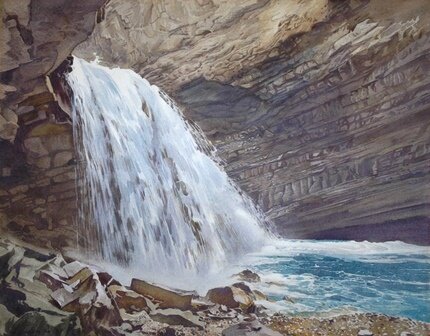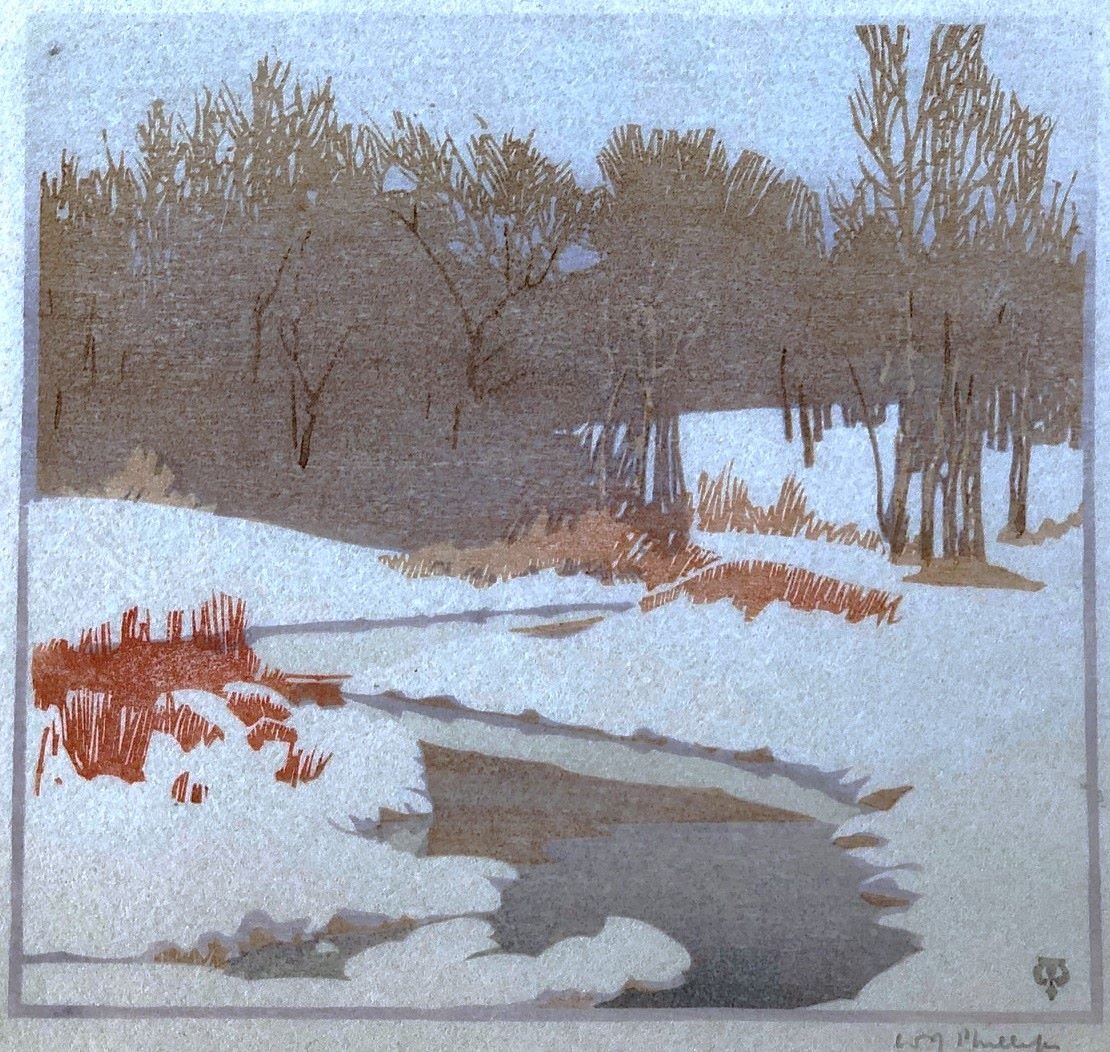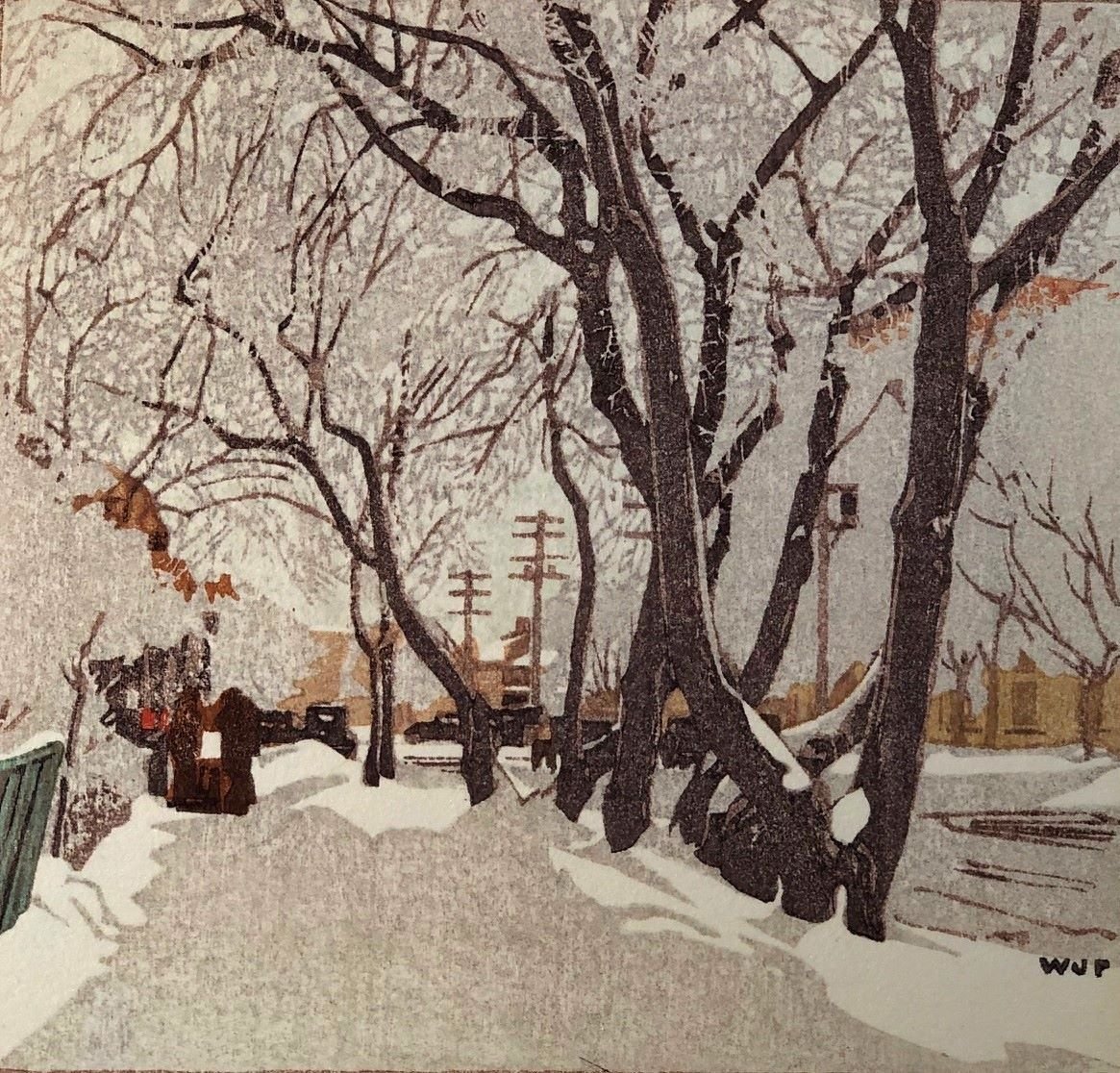Walter J. Phillips RCA
1884-1963

Summer Night, 1931, edition 200, colour woodcut, 6.75 x 9.5 inches (17 x 24 cm), Provenance: Alberta Collection, Description: MBL153, fifth print in Portfolio "Ten Woodcuts", signed l.r. (WJ Phillips), condition: excellent, archival framing with museum glass, $4400 Cdn.

The Diving Board, 1930, colour woodcut on paper, 8.5 x 5.5 inches (22 x 14 cm), Description: MBL131, signed with monogram top right, signed in graphite l.r., the print was re-issued in 1931 in an edition of 200, reproduced p.117 in Roger Boulet book The Tranquility and the Turbulence. Provenance: private collection Alberta, condition: excellent, archival framing with museum glass, $5200 Cdn.

Wild Cherry, 1927, ed. 66/250, colour woodblock on Goyu paper, 5.5 x 8.75 inches (14 x 22.2 cm), Description: 10th print of Ten Canadian Colour Prints Portfolio from 1927, signed with monogram in block l.l., in graphite lower margin l.l. signed and numbered; Provenance: private collection Banff, archival framing, $3000 Cdn.

Moonlight, Lake Of The Woods, 1927, ed. 66/250, colour woodcut on Goyu paper, 7x6 inches (18x15 cm), archival framing in handcrafted Arts & Crafts style frame; Description: MBL102, 5th print of Ten Canadian Colour Prints Portfolio from 1927; signed with monogram in block l.l., in graphite lower margin l.l. numbered, l.r. signed; Provenance: private collection Calgary; $3600 Cdn.

Framed in a contemporary, handcrafted Arts & Crafts Style frame (photographed under glass).

Fishing Boats, Gimli Dock, 1937, wood engraving, 4.25 x 6.5 inches (10 x 16 cm), Description: MBL221, signed l.r. (WJ Phillips), reproduced p.230 in Roger Boulet book The Tranquility and the Turbulence, Christmas greeting for 1937. Provenance: private collection Alberta, condition: excellent, archival framing with museum glass, $4200 Cdn.

Valley Of The Ten Peaks, 1930, ed. 200, wood engraving, 4.25 x 6.25 inches (12 x 16 cm), Description: l.r. signed (WJ Phillips) in graphite; the ninth print in the portfolio Ten Woodcuts of 1931, MBL147, Provenance: Calgary Collection, condition: excellent, archival framing with museum glass, $4200 Cdn.

Snake Island, Lake Winnipeg, 1931, ed. 40, wood engraving, 5.25 x 7.75 inches (13.5 x 19.5 cm), Description: MBL157, tenth print in Portfolio "Ten Woodcuts", signed l.l. (WJ Phillips), reproduced p.222 in Roger Boulet book The Tranquility and the Turbulence. Provenance: Calgary Collection, condition: excellent, archival framing with museum glass, $3900 Cdn.

Engineer's House and South Wall, 1931, edition 971, wood engraving, 3.25 x 4.5 inches (8 x 11 cm), Note: MBL181; l.l. signed (WJ Phillips); This print was the 1931 Christmas Card; Provenance: private collection Calgary, archival framing with museum glass, $1650 Cdn.

Fall, Assiniboine River, 1931, colour woodcut, edition 200, 7 x 10 inches (17 x 25 cm), Provenance: Banff Collection, Description: MBL150, second print in Portfolio "Ten Woodcuts", signed with monogram l.r., signed l.r. (WJ Phillips), condition: excellent, archival framing with museum glass, $3650 Cdn.

Fall, Assiniboine River, 1931, colour woodcut, edition 200, 7 x 10 inches (17 x 25 cm), Provenance: Calgary Collection, Description: MBL150, second print in Portfolio "Ten Woodcuts", signed with monogram l.r., signed l.r. (WJ Phillips), condition: excellent, archival framing with museum glass, $3650 Cdn.

Mount Nicholas, 1940, colour woodcut, 4.25 x 5 inches (10 x 12 cm), Provenance: Alberta Collection, Description: MBL227, Christmas greeting 1940, titled l.l. (Mt. Nicholas) in graphite, signed l.r. (WJ Phillips) in graphite, condition: very good, archival framing with museum glass, $2450 Cdn.

Johnston Canyon Waterfall, 1948, watercolor on paper, 15 x 19 inches, archival framing; l.l. signed and dated (WJ Phillips 48); Provenance: purchased from the artist, private collection British Columbia, sold

Canmore, 1947, colour woodcut, 3.75 x 5 inches (9 x 12 cm), Description: l.r. signed (WJ Phillips) in graphite; the 1947 Christmas greeting, MBL242, reproduced p.161 in Roger Boulet book The Tranquility and the Turbulence, Provenance: Alberta Collection; condition: very good, archival framing with museum glass, sold.

The Stream In Winter, 1935, colour woodcut, 4 x 4.5 inches (10 x 11 cm), Provenance: Calgary Collection, Description: MBL 213, 1935 Christmas greeting; tenth print in Portfolio "Winter Woodcuts", signed with monogram in block l.r., in graphite lower margin l.r., reproduced p.120 in Roger Boulet book The Tranquility and the Turbulence, archival framing with museum glass, sold.

Warren's Landing, Lake Winnipeg, 1931, edition 200, colour woodcut, 6.25 x 9.5 inches (16x24 cm), Provenance: Calgary Collection, Description: MBL154, sixth print in Portfolio "Ten Woodcuts", signed l.r. (WJ Phillips), condition: excellent, archival framing with museum glass, sold.

Assiniboine River From Big Springs (Manitoba Landscape), 1929, edition unknown, colour woodcut on paper, 3 1/4 x 4 5/8 inches (8.3 x 11.7 cm), archival framing; MBL126; l.l. inscribed (WP) with Assiniboine written in graphite on bottom corner of margin; l.r. signed (WJ Phillips); featured in Roger Boulet book The Tranquility and the Turbulence page 112. This was the Phillips' 1929 Christmas greeting. Provenance: private collection British Columbia, sold

Mountain Torrent, 1926, colour wood cut / laid japan paper (Japanese printmaking paper), 8 ¾ x 11 7/8 inches (22.2 x 31.2 cm); Description: in graphite lower margin l.l. titled, editioned, dedicated to Reg Harvey; l.r. signed (WJ Phillips); l.l. dated 1926 in the block and monogrammed; original framing (new archival mat); MBL89; reproduced p.205 in Roger Boulet book The Tranquility and the Turbulence. Provenance: private collection Alberta, sold.

Grain Elevator At LaSalle, Manitoba, 1931, edition 200, colour woodcut, 7.25 x 12.5 inches (19 x 31 cm), Provenance: Alberta Collection, Description: MBL149, first print in Portfolio "Ten Woodcuts", signed l.r. (WJ Phillips), condition: very good, archival framing with museum glass, sold.

The Source Of The Bow, 1936, wood engraving/paper, 6 1/2 x 4 3/8 inches (16.4 x 10.6 cm), archival framing; Note: MBL217; l.r. signed (WJ Phillips); This print was the 1936 Christmas Card; This work is in the National Gallery of Canada Permanent Collection; Provenance: private collection Alberta, sold.

Our Street, 1933, colour woodcut, 3.5 x 6 inches (8 x 15 cm), Description: reproduced p.191 in Roger Boulet book The Tranquility and the Turbulence, MBL191, archival framing with museum glass, sold.

Rushing River, Lake Of The Woods, 1931, wood engraving, 5 3/8 x 6 3/8 inches (13 x 17 cm), Description: the eighth print in the portfolio Ten Woodcuts of 1931, archival framed, sold.

Rime, 1934, colour woodcut, signed/inscribed, sold.

Rosie, 1918, edition at 50, 1st state, colour woodcut/paper, 5.5 x 4.5 inches (13 x 11 cm), Description: MBL34A, signed, titled, dated lower margin; signed with monogram l.r., reproduced p.40 in Roger Boulet book The Tranquility and the Turbulence, Provenance: Banff Collection, archival framing with museum glass, sold.

Totems, Alert Bay, 1936, colour woodcut, sold.

Corral At Banff, 1941, colour woodcut, 4 x 3.5 inches (10 x 9 cm), This print was the 1941 Christmas Card; Provenance: Calgary Collection, Description: MBL156, condition: excellent, archival framing with museum glass, sold.
Walter J. Phillips masterfully captured local landscapes and the activities of people within them, utilizing techniques rooted in Japanese woodcut processes.
Bibliography
Ainslie, Patricia. "Images Of The Land, Canadian Block Prints, 1919-1945." Calgary: Glenbow Museum, 1984.
Boulet, Roger. "The Tranquility and the Turbulence: The Life and Works of Walter J. Phillips." Markham, ON.: M.B. Loates Publishing, 1981.
Boyanoski, Christine. "A Century Of Printmaking In Canada: A Selection of Prints from the Canadian Historical Collection of the Art Gallery of Ontario." Toronto: Art Gallery of Ontario, 1986, p.4-5.
Cochran, Bente Roed. "Printmaking In Alberta 1945-1985." Edmonton: University of Alberta Press, 1989.
Newlands, Anne. "Canadian Paintings, Prints and Drawings." Richmond Hill, ON: Firefly Books, 2007.
Phillips, Walter J. and Frederick Niven. "Colour In The Canadian Rockies." Toronto: Thomas Nelson and Sons Ltd., 1937.
Reid, Dennis. "A Concise History of Canadian Painting (Third Edition)." Don Mills, ON: Oxford University Press, 2012.
Phillips believed that good art is anchored in the specific, and his distinct perspective reflects a deep commitment to place and a thoughtful engagement with the art traditions of the past. His diverse depictions of people and scenery reveal his wide-ranging interests within the natural and human worlds he inhabited. By skillfully harnessing light and colour, Phillips not only set the scene but also offered intimate glimpses into his environment.
Internationally acclaimed during his lifetime, Walter J. Phillips was renowned for his expertise in colour woodcutting, a craft adapted from Japanese methods. Through the meticulous layering of transparent water-based inks, he created works of remarkable beauty, subtlety, and depth.
Walter J. Phillips was born in 1884 in Barton-on-Humber, Lincolnshire, England, the son of Reverend John Phillips, a Methodist minister. As a teenager, he attended the Birmingham School of Art once a week, studying under Edward R. Taylor. Hoping to earn enough money to study art in Paris, he traveled to South Africa for several years but returned with little more than he had left with. By 1908, Phillips had worked as a commercial artist in Manchester and London. From 1908 to 1911, he served as the art master at Bishop Wordsworth’s School in Salisbury, England. In 1911, he held his first solo exhibition in Salisbury, which was both critically and financially successful.
In December 1910, he married Gladys Pitcher, and in 1913, the couple decided to emigrate to Canada, arriving in Winnipeg in June of that year. Shortly after his arrival, a fellow artist introduced him to the etching technique and sold him his tools, setting the stage for his future as a printmaker. From 1915 to 1918, Walter J. Phillips produced etchings in very small editions before transitioning to colour wood cut prints, a medium he found more suited to his artistic vision. During the summers of 1917 and 1919, he taught at the University of Wisconsin, and by that time, his work had gained both national and international recognition. By 1923, he had published forty-two colour woodcuts.
On a trip to England in 1924, Phillips was introduced to Yoshijiro Urushibara, a master of Japanese printmaking. Urushibara taught him essential techniques, including paper sizing and registration on the woodblock. Inspired by this experience, Phillips produced thirty-nine prints between 1926 and 1928.
By this point, he had firmly established his own method for creating woodcuts: first, a graphite sketch, followed by a finished watercolour; then, a refined sketch to compose the woodcut, culminating in the final print.
Phillips was so highly regarded that, even during the Great Depression, he was among the few artists able to support himself through the sale of his paintings and woodcuts. Art historian Anne Newlands describes him as "Canada's foremost colour-woodcut artist between the wars" (Newlands 246). From 1925 to 1935, his subjects were primarily drawn from the Prairies, but by 1946, he focused largely on the Rocky Mountains. Throughout his career, he also remained a prolific book illustrator.
In 1940, Phillips joined the Banff Summer School of Fine Arts as a staff member. The following year, he moved to Calgary to teach at the Institute of Technology and Art, where he remained until 1949. In 1953, he relocated to Banff, where he and his wife built a home along St. Julien Road on Tunnel Mountain. By 1958, Phillips' eyesight had begun to fail, and in 1960, he retired to Victoria. He passed away in 1963 at the age of 78, and his ashes were scattered in the Alberta mountains he loved so deeply.
